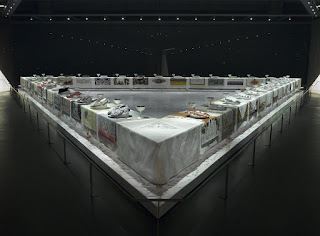 |
| Georges Braque, 'Bottle and Fishes' c.1910–2 |
 |
| Modernism, Post-Modernism, and Dada in a Nutshell |
It was a much-changed world after World War I; industrialization and urbanization took its course. Art transformed into a whole different level with cultural trends and changes. However, despite the advances in literature and other domains, women artists were still being treated poorly and not serious at all. Similarly to the male gaze, women were also, still being depicted as objects in paintings. Women were fed up with all of this occurring, and they took action. A few women tried to bring awareness to this case through their paintings, and others followed in their footsteps.
 |
| Georgia O'Keeffe, Ram's Head White Hollyhock and Little Hills 1935, The Brooklyn Museum |
 |
| GEORGIA O'KEEFFE, “Heliconia,” 1939, oil on canvas, 19 x 16 in, Private collection |
After modernism came the era of postmodernism. It was the ideology of bringing back tradition in arts. “Architecture saw a return to traditional materials and forms and sometimes to the use of decoration for the sake of decoration itself, as in the work of Michael Graves and, after the 1970s, that of Philip Johnson.” (Britannica) It was an essentially a reaction against modernism. The term first being used in 1970, postmodernism took its course and said to begin with pop art and then, later on, embraced conceptual art, neo-expressionism, feminist art, and the Young British Artists of the 1990s. “Postmodernism was a reaction against modernism. Modernism was generally based on idealism and a utopian vision of human life and society and a belief in progress. While modernism was based on idealism and reason, postmodernism was born of skepticism and a suspicion of reason.” (Tate) What this fundamentally means is that postmodern art was attached to the ideology that grew with mid 20th century to late 20th-century philosophy; which produced the main focus of individualism and interpretation rather than abstract principles. Tate states, “While the modernists championed clarity and simplicity; postmodernism embraced complex and often contradictory layers of meaning.”
 |
| Judy Chicago, The Dinner Party, 1974 - 1979, mixed media, 48 x 48 ft., Elizabeth A. Sackler Center for Feminist Art, Collection of the Brooklyn Museum. |
Judy Chicago’s, The Dinner Party is an excellent example of postmodernism art and an essential icon of 1970s feminist art. It is an exhibition that comprises a triangular table consisting of 39 place settings, which honored important women of history. It was an efficient way to resemble feminist art, and it shows how great women can be. Each women being honored had distinctive styles appropriate to distinguish them from the others. A total of 1,038 women are being honored in this exhibition, with the names of 999 other women embroidered in gold below the table.
Work Citied
Chadwick, Whitney. Women, Art and Society. Thames and Hudson, 2015.
The Guerrilla Girls' Bedside Companion to the History of Western Art. Penguin Books, 2006.
No comments:
Post a Comment
Note: Only a member of this blog may post a comment.